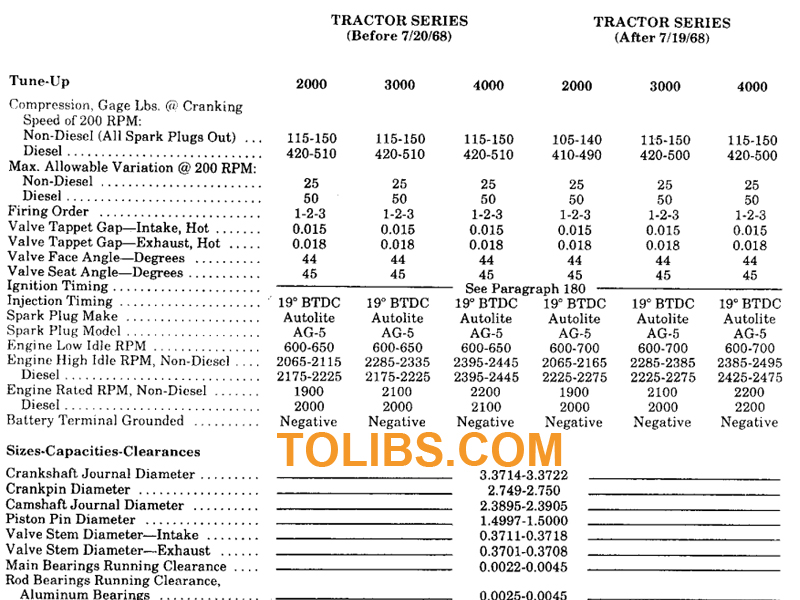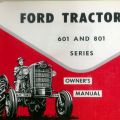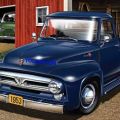Ford Tractor 2000, 3000, 4000 Series Workshop Manual

Ford 4000 Series (4110, 4140) Shop Manual
FRONT SUPPORT Model 4200
R&R FRONT PEDESTAL
ASSEMBLY. First, drain cooling system, then remove engine hood and radiator grille assembly. Disconnect radiator hoses and remove radiator from pedestal. Remove covers from top of pedestal and disconnect power steering lines (17 and 18-Fig. 43) from manifold (39). Support front end of tractor and remove wide front axle assembly as outlined in paragraph 52, or if a tricycle model, unbolt and remove the spindle and wheel assembly from steering shaft. Attach a hoist to front support, then unbolt and remove front support from engine cylinder block and oil pan. Note: Be careful not to lose or damage shims, if any, located on front support to oil pan bolts.
OVERHAUL PEDESTAL
ASSEMBLY. With the pedestal removed from tractor as outlined in paragraph 51, proceed as follows: Remove the nuts from power cylinder rear end assemblies and bump rear ends of cylinders from front support. Remove the cap screws (23-Fig. 43) clamping cylinder front end assemblies in steering shaft arm (22) and remove cylinder from arm. Unbolt manifold (39) from pedestal and lift out manifold, lines and cylinders as a unit. Refer to paragraph 65 for service information on the power cylinders.
Pry cap (25) from pedestal and remove cotter pin and castellated nut (26). Bump steering shaft (34) downward out of pedestal and lift out the upper bearing cone and roller assembly (27) and steering arm (22). Remove lower bearing cone and roller assembly (32) from steering shaft and remove bearing cups (28 and 31) and seals (29, 30 and 33) from the pedestal.
To reassemble, drive new bearing cups (28 and 31) into pedestal until firmly seated. Drive or press lower bearing cone and roller assembly (32) onto steering shaft until seated. Install lower seal (5.51 O.D.) (33) into pedestal with lip up. Install the 3.35 O.D. seal (30) with lip down and the 2.25 O.D. seal (29) with lip up. Pack the bearings with grease and while holding steering arm (22) in position, insert steering shaft up through pedestal. Insert upper cone and roller assembly (27) into cup and onto shaft and install nut (26).
Tighten nut so that all steering shaft end play is removed and bearings are slightly preloaded, then install cotter pin and cap (25). Reconnect steering cylinders to steering arm and pedestal and install manifold (39) to pedestal retaining cap screws- Reinstall pedestal as outlined in paragraph 52.
POWER STEERING SYSTEM Model 4200
CAUTION: The maintenance of absolute cleanliness of all parts is of the utmost importance in the operation and servicing of the hydraulic power steering system. Of equal Importance is the avoidance of nicks or burrs on any of the working parts.
FLUID AND BLEEDING
Recommended power steering fluid is Ford M-2C41A oil. Maintain fluid level to full mark on dipstick. After each 600 hours of operation, it is recommended that filter element be changed and reservoir cleaned.
The power steering system is selfbleeding . When unit has been disassembled, refill reservoir to full level, start and idle engine , and refill if level lowers. Cycle steering gear by turning steering wheel fully in each direction al least five times , maintain fluid level at or near full mark . System is fully bled when no more air bubbles appear in reservoir , steering action is steady and solid, and fluid level ceases to lower.
SYSTEM PRESSURE AND FLOW
The power steering pump assembly incorporates a pressure relief valve and a flow control valve. System relief pressure should be 1100 psi. All models are equipped with a flow control valve which maintains a regulated flow of 3.5 gpm at 1000 engine rpm.
STEERING SYSTEM TROUBLESHOOTING
Refer to the following paragraphs for checking causes of steering system malfunction: HARD STEERING . Check column hearings and bearings in Hydramotor unit renew if rough or damaged. Check ring, rotor and vanes for wear and renew the assembly if necessary. Check for sticking control valve spool or blocking spool in Hydramotor clean valves or renew Hydramotor unit as required.
EXCESSIVE WHEEL DRIFT
Check blocking spool spring and guide assembly and renew if spring is broken . Check for leakage past blocking valve if excessive, renew Hydramotor unit. Check seals on steering cylinder pistons and renew pistons and/or cylinder inner tubes as required.
R&R HYDRAMOTOR UNIT
To remove the steering unit, first remove fuel tank. Then, proceed as follows: Unbolt and remove the steering wheel and shaft assembly from fuel tank and steering support. Disconnect the two cylinder lines and the pump pressure: and fluid return lines from steering motor (21-Fig. 45). Unbolt the bracket and motor (21), then remove bracket and motor from support (18).
Reverse removal procedure to reinstall the steering motor unit using new "0" rings when reconnecting fluid lines. Before reinstalling fuel tank, run engine on nurse tank to fill and bleed the power steering system as outlined in paragraph 54. After being sure no fluid leakage is occuring, reinstall fuel tank. CAUTION: The blocking, (reaction) valve adjuster (1-Fig. 48) must be irl position shown in Fig. 50 before reinstalling fuel tank.
R&R BLOCKING SPOOL (REACTION) VALVE
The blocking spool valve and related parts can be removed and reinstalled after the Hydramotor steering unit has been removed as outlined in paragraph 59. Refer to Fig. 48 and proceed as follows:
Remove the lockout adjuster nut (1). Plug (3),and spool valve (4) may new be removed by pushing the plug into bore against spring pressure with `screwdriver t then quickly releasing the plug to alldw spring to pop it out of bore. Remove plug- and, if Spool sticks in bore, invert the unit and tap housing (12) with soft faced mallet to jar spool out. Invert unit and allow spring (5) and spring and guide assembly (6) to drop from bore.
Spool is not serviced separately from complete Hydramotor unit. Renew other parts as necessary, or install new Hydramotor unit if spool and/or spool bore in housing are not serviceable. To reassemble, install parts in bore of housing (12) as shown in exploded view, renewing the "O" ring (2) on plug (3) and tightening adjuster nut to a torque of 10-15 Ft.-Lbs. Note: The adjuster (1) is not accessible after tractor is fully assembled thus, the adjuster must be in position shown in Fig. 50 when unit is being reinstalled.
R&R COVER RETAINING SNAP RING
To remove snap ring (7-Fig. 46) used to retain cover (30) to housing (12), proceed as follows: With unit removed from tractor as outlined in paragraph 59, check to set that end gap of snap ring is near hole ih cover as shown in Fig. 49 if not, bump snap ring into this position with hammer and punch. Insert a pin punch into hole and drive punch inward to dislodge snap ring from groove. Hold punch under snap ring and pry ring from cover with screwdriver. Usually, the coil spring (27-Fig. 46) will push housing from cover if not, bump cover loose by tapping around edge with mallet as shown in Fig. 50.
To reinstall the cover retaining snap ring, housing must be held in cover against pressure from spring. It is recomended that the unit be placed in nn arbor press and the housing he pushed into cover with a sleeve as shown in Fig. 5]. CAUTION: Do not push against end of shaft (14-Fig. 46). Place snap ring over housing before placing unit in press. Carefully apply force on housing with sleeve until flange on housing is below snap ring groove in cover. Note that lug on housing must enter slot in cover. If housing binds in cover, do not apply heavy pressure remove unit from press and bump cover loose with mallet as shown in Fig. 50. When housing has been pushed far enough into cover, install snap ring in groove with end gap near hole in the cover as shown in Fig.49.
OVERHAUL HYDRAMOTOR STEERING UNIT
With the unit removed from tractor as outlined in paragraph 59 and the cover retaining snap ring removed as outlined in paragraph 61, proceed as follows:
Clamp flat portion of hydramotor housing in a vise and remove cover (30 -Fig. 46) by pulling upward with a twisting motion. Remove the pressure plate spring (27), then remove cap screws (51) and lift off the pressure plate (23) as shown in Fig. 52. Remove the dowel pins (Fig. 53), then remove snap ring (21) from shaft (14) with suitable snap ring pliers and screwdriver discard the snap ring. Pull pump ring and rotor assembly (20) up off of shaft as shown in Fig. 54. Tap outer end of shaft with soft faced mallet as shown in Fig. 55 until bearing support (15) can be removed, then carefully remove the actuator shaft assembly from housing as shown in Fig. 57. Note: As the actuator shaft and control valve spool assembly is a factory balanced unit and is not serviceable except by renewing the complete Hydramotor steering unit, it is recommended that this unit not be disassembled.
Carefully clean and inspect the removed units. Refer to paragraph 60 for information on the blocking valve assembly. If the housing control valve bore or blocking valve bore are deeply scored or worn, or if the blocking valve spool or the actuator shaft and control valve spool assembly are damaged in any way making the unit unfit for further service, a complete new Hydramotor steering unit must be installed. If these components (housing, blocking valve and actuator assembly) are serviceable, proceed with overhaul as follows:
Remove the check valve retainers (26-Fig. 46), springs (25) and check valve balls (24) from pressure plate (23) and blow passages clear with compressed air. Renew the pressure plate assembly if check valve seats or face of plate are deeply scored or damaged.
Renew needle bearing (22), springs (25) and/or check valve balls (24) if damaged and pressure plate is otherwise serviceable. Note: Drive or press on lettered (trademark) end of bearing cage when installing new needle bearing. If bearing support (15) is otherwise serviceable, a new needle bearing (17) may be installed drive or press only on lettered end of bearing cage.
Remove snap ring (8), dust seal (9) and oil seal (10) and inspect the needle bearing (11) renew needle bearing if worn or damaged. Press only on lettered (trademark) end of bearing cage when installing new bearing. Install oil seal with lip towards inside (needle bearing), then install dust seal and retaining snap ring.
If the rotor ring, rotor or vanes are worn, scored or damaged beyond further use, or if any of the vane springs are broken, renew the unit as a complete assembly (20). If unit was disassembled and is usable, reassemble as follows: Place ring on flat surface and place rotor inside ring. Insert vanes with rounded edges out in the rotor slots aligned with large inside diameter of ring, turn the rotor 1/4-turn and insert remaining vanes. Hook the springs behind the vanes with a screwdriver as shown in Fig. 60, then turn the assembly over and hook springs behind the vanes on opposite side of rotor.
To reassemble the Hydramotor unit, place housing (with needle bearing, seals and snap ring installed ) in a vise with flat (bottom) side up. Check to be sure that pin in actuator is engaged with hole in valve spool if spool can be pulled away from actuator as shown in Fig. 58, push the spool back into actuator and be sure pin is engaged in one of the holes in spool. Then, lubricate spool and shaft and carefully insert the assembly into bore of housing. Place bearing support, with outside "0" ring and needle bearing installed, on shaft and carefully push the support into housing as shown in Fig. 59. Insert rotor sealing "O" ring and rotor seal into bearing support. Place ring and rotor assembly on shaft and housing with chamfered outer edge of ring up (away from housing). Install a new rotor retaining snap ring and insert the dowel pins through ring into housing. Using heavy grease , stick the "0" ring and rotor sealing ring into pressure plate, then install the pressure plate assembly over shaft, pump ring and rotor assembly and the two dowel pins. Install the two pressure plate retaining cap screws (31-Fig. 46), tighten them to 96- 120 In Lbs. of torque, then back off the two cap screws 1/2 to % turn. Be sure bolt head corners are within perimeter of cover as shown in Fig. 47. NOTE: A minimum torque of 10 In Lbs. must remain on each cap screw after they have been backed off. Place the coil spring on top of pressure plate. Install new "0" ring and backup ring in second groove of cover (See Fig. 61), lubricate the rings and push cover down over the pressure plate and ring. While holding the cover on the assembly, place the unit in an arbor press and insert the- cover retaining snap ring as outlined in paragraph 61.












